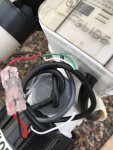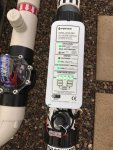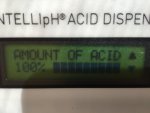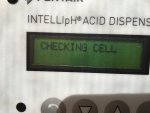All,
Frankly, I have had my doubts regarding the opinions or assumptions that the IntelliChlor stops producing chlorine during times of IntellipH dosing. These doubts "were" mostly based on the fact that I was unable to find ANY written reference from Pentair regarding this apparent feature.
I also doubt that the dosing of acid during the times of chlorine production from an IntelliChlor has any negative side-effects to equipment. Again, I can find no documentation that confirms this fact, only speculation and conjecture.
I decided to conduct my own experimentation to see if I could duplicate what
@Dirk had observed. He had stated that he observed the IntelliChlor cell temporarily “shut down” production of chlorine when the IntellipH doses acid.
I can only assume that he noted some type of visual change of status lights on his IntelliChlor Cell Control Panel during this time of IntellipH acid dosing in order to make this claim. I had never observed such an occurrence but that doesn’t mean it didn’t happen with my IntelliChlor. It just means that I did not happen to observe it.
Note: He operates an IC-40 and I operate an IC-60. I wasn't sure if that made a difference or not.
Since my pool water is too cold to allow the IC-60 to produce chlorine (cold water shutoff feature), I cut the white wire between the thermistor in the flow switch assembly and the cell. I did not have to cut the green wire because I have the newer version of the flow switch assembly, so there is no green wire to cut.

I then turned the filter pump on and tested the IntelliChlor and it was on and the “Cold Water – System Off” light was NOT illuminated. All other indicator lights were normal after the IntelliChlor temporary start-up sequence was complete.
Here are the steps that I used to conduct my experiment.
1. Pump and IntelliChlor on.
2. Set sanitizer output to 100% This would cause the cell to produce chlorine for 265 seconds (4.42 min) of each 5-minute period.
3. Set IntelliChlor to "Boost" or “Super Chlorinate".

4. I set the IntellipH dosing amount to 100% (60 second dosing event once each hour). I then observed on the IntellipH controller screen that automatic dosing would occur in 60 minutes. I came back in 55 minutes and I waited.

Once automatic acid dosing began (the IntellipH first indicates “
CHECKING CELL” before power is delivered to the peristaltic pump). I then observed the IntelliChlor Cell Control Panel for ANY indication that chlorine production was being stopped/halted.

The sanitizer output lights
ALL went
OFF and the CELL Status light was NOT illuminated, during the time period that acid dosing was taking place. They immediately came back on at the termination of acid dosing.

4. Next, I waited 5 minutes and performed an IntellipH manual dosing. Manual dosing’s always run for 60 seconds. Once again, the same exact result.
Summary. I can confirm the following fact:
THE INTELLICHLOR INDICATES NO CHLORINE OUTPUT DURING THE TIME OF INTELLIPH ACID DOSING! Based on my experimentation as noted above.
Am I stating empirically, that chlorine production is halted by IntelliChlor during times of IntellipH acid dosing? Nope. I have no way of proving that. However,
ALL of the output lights AND the CELL STATUS light cease to be illuminated during acid dosing.
That’s good enough for me!
I would welcome anyone to disprove my belief now that an
IC-60 (non-commercial model (i.e., CIC60P), IntelliChlor does in fact halt chlorine production, during times of IntellipH acid dosing (automatic or manual mode).
Pentair MUST have a reason for this. However, I still cannot find any substantial “proof” that the dosing of normal pool-type muriatic acid during times of IntelliChlor chlorine production causes any damage to equipment.
I am still of the belief that an IntelliChlor cannot produce enough chlorine in a solution of running water with a pH of approximately 7.6ppm to produce enough chlorine gas buildup to produce any ill side-effects to the equipment.
Information that I have found suggests that the IntelliChlor IC-60 (in boost/super chlorinate mode), can produce approximately two pounds of chlorine in 24 hours running at boost. That will raise the chlorine level approximately 2ppm for 1 million pounds of water or approximately ~10ppm in 20,000 gallons over 24 hours.
However, in real-world operations, the IntelliChlor isn't converting anywhere near that in most cases.
The IntelliChlor cell is designed to operate at a flow rate of 25gpm +/- 5gpm.
That means that if one is running at boost with the chlorinator, then the worst that could happen is the adding of
0.001 ppm of chlorine to a gallon of water in one minute.
Contrast that to WWI, where chlorine gas used in combat was approximately 600ppm, and which would incapacitate and eventually kill in 30 minutes.
r.








